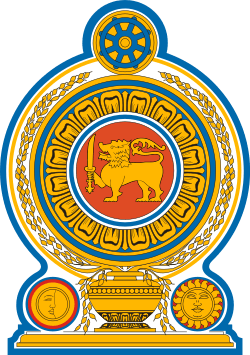Early kingdoms period
Part of a series on the |
||||||||||||||||||
|---|---|---|---|---|---|---|---|---|---|---|---|---|---|---|---|---|---|---|
| History of Sri Lanka | ||||||||||||||||||
 | ||||||||||||||||||
| Chronicles | ||||||||||||||||||
| Periods | ||||||||||||||||||
|
||||||||||||||||||
| By Topic | ||||||||||||||||||
|
| ||||||||||||||||||
The Early kingdoms period of Sri Lankan history begins with the gradual onset of historical records in the final centuries BC, ending the prehistoric period. According to the Mahavamsa, the original inhabitants of Sri Lanka are the Yakshas and northern Naga tribes. Sinhalese history traditionally starts in 543 BC at the arrival of Prince Vijaya, a semi-legendary king who was banished from the Indian subcontinent with his 700 followers, and is recorded in the Mahavamsa chronicle. This period was succeeded by the Anuradhapura period.
Background
According to folklore, the Naga people were one of the groups of original inhabitants of Lanka. They were said to have ruled Nagadeepa, or Jaffna Peninsula and Kelaniya. Naga people were snake-worshipers, and may have been a race of the Dravidians.[1] The word Naga was sometimes written in early inscriptions as Nāya, as in Nāganika – this occurs in the Nanaghat inscription of 150 BC. Until the third century BC they appear as a distinct group in the early Sri Lankan chronices as well as the early Tamil literary works.[2] In the third century BC they started to assimilate to Tamil language and culture, and lost their separate identity.[3]
Kingdom of Tambapanni
The Kingdom of Tambapanni existed from 543 BC to 505 BC. According to Mahavamsa, the legendary Prince Vijaya and seven hundreds of his followers came to Sri Lanka after being expelled from Sinhapura in India. Vijaya is said to have landed on the island on the day of Gautama Buddha's death, and after reaching the heaven, the Buddha asked the deities to protect him so that he could spread Buddhism in Sri Lanka. Prince Vijaya established the Kingdom of Tambapanni. He married a local Yakkhini named Kuveni, and their children gave rise to the Pulinda race (identified with the Vedda people). Vijaya also married a princess of the Pandu kingdom (identified with Pandyan kingdom), but did not have any children with her. His followers also married maidens sent by the Pandu king, and their descendants gave rise to the Sinhalese race.[4][5]
Kingdom of Upatissa Nuwara
The Kingdom of Upatissa Nuwara existed from 505 to 377 BC when the ruling monarch, Pandukabhaya moved the administration to Anuradhapura. Pandukabhaya was the last monarch of Upatissa Nuwara and the first of Anuradhapura.
Sources
The Pali chronicles, the Dipavamsa, Mahavamsa, Thupavamsa[6] and the Culavamsa as well as a large collection of stone inscriptions,[7] the Indian Epigraphical records, the Burmese versions of the chronicles etc., provide an exceptional record for the history of Sri Lanka from about the sixth century BC.
The Mahavamsa, written around 400 AD, using the Dipavamsa, the Attakatha and other written sources available, it correlates well with Indian histories of the period. Emperor Asoka's reign is recorded in the Mahavamsa. The Mahavamsa account of the period prior to Asoka's coronation, (218 years after the Buddha's death) seems to be part legend. The account of the Mahavamsa, a Pali text written largely from the Sinhalese perspective, has mythological beginnings but becomes historical from the third century BC, with the arrival of Buddhism under Devanampiya Tissa of Sri Lanka. Epigraphic sources also appear with the presence of Buddhism, from about the third century BC. The earliest historiographic litearature, such as the Mahavamsa, dates to the sixth century AD. The entire ancient period of history written in the Mahavamsa, is dominated by the Anuradhapura Kingdom. The medieval period in Sri Lanka is taken to begin with the fall of the Anuradhapura Kingdom in AD 1017.
Legacy
Within Sri Lanka, the legend of Vijaya is often treated as a factual account of a historical event. However, multiple scholars consider the legend of dubious historicity. Satchi Ponnambalam called it a "pure flight of fantasy".[8] According to Gavin Thomas, the narration of historical events in Mahavamsa and its continuation Culavamsa is "at best questionably-biased, and at worst totally imaginary", aimed at establishing the royal lineage of the Sinhalese and the Buddhist credentials of the island.[9] According to H.W. Codrington, Vijaya is probably a composite character, and the legend is aimed at connecting the early history of Sri Lanka with that of Buddha.[10]
See also
References
- ↑ Smid, Laura (2003). South Asian folklore: an encyclopedia : Afghanistan, Bangladesh, India, Pakistan, Sri Lanka. Great Britain: Routledge. ISBN 0415939194. p. 429.
- ↑ Holt, John (2011), The Sri Lanka Reader: History, Culture, Politics, Duke University Press, p. 73
- ↑ Holt, John (2011), The Sri Lanka Reader: History, Culture, Politics, Duke University Press, p. 73–74.
- ↑ John M. Senaveratna (1997). The story of the Sinhalese from the most ancient times up to the end of "the Mahavansa" or Great dynasty. Asian Educational Services. pp. 7–22. ISBN 978-81-206-1271-6.
- ↑ Mudaliyar C. Rasanayagam (1984). Ancient Jaffna. Asian Educational Services. ISBN 9788120602106.
- ↑ Geiger-Bode translation of the Mahavamsa. lakdiva.org
- ↑ Paranavithana Epigraphics Zeylanica
- ↑ Bruce Kapferer, ed. (2012). Legends of People, Myths of State. Violence, Intolerance, and Political Culture in Sri Lanka and Australia. Berghahn. pp. 34–37. ISBN 978-0-85745-436-2.
- ↑ Gavin Thomas (2009). The Rough Guide to Sri Lanka. Penguin. p. 415. ISBN 9781405385169.
- ↑ Humphry William Codrington (1926). "The beginnings; and the Conversion to Buddhism". A short history of Lanka. Macmillan. Retrieved 20 October 2015.
Bibliography
- Kāmboja, Jiyālāla (1981). Ancient Kamboja, People and the Country. Isṭarana Buka Liṅkarsa. OCLC 14053560.